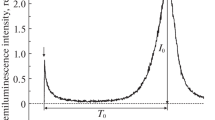Abstract
Inhibiting effect of tea catechins on the lipid peroxidation induced by tritiated water was studied. In our previous reports, it was found that the inhibiting effects of (−)-epigallocatechin gallate (EGCg) was decreased in the concentration range of above 5.0·10−5 M. In this study, the reason of decrease was revealed using fluorescence analysis and electron spin resonance, and its inhibiting mechanism of EGCg was considered. The decrease of the inhibiting effect was mainly attributed to the interaction between lipid membranes and EGCg. EGCg induced aggregation of liposomes with interacting with membranes at its concentration range of above 5.0·10−5 M. Finally, EGCg broke the membrane at its concentration range of above 1.0·10−3M. Furthermore, autoxidation of EGCg did not influence on the inhibiting effects of the lipid peroxidation under these conditions. Thus, inhibiting effect of EGCg was attributed to the amount of EGCg adsorbed on the membranes, but membrane structure was broken by adsorption of large amount of EGCg on the membranes.
Similar content being viewed by others
References
S. Tore, Health Phys., 65 (1993) 673.
W. Deng, D. P. Morrison, K. L. Gale, J. N. Lucas, Radiat. Res., 150 (1998) 400.
M. Karbownik, R. J. Reiter, Exp. Biol. Med., 225 (2000) 9.
H. Yoshioka, H. Kurosaki, K. Yoshinaga, K. Saito, H. Yoshioka, Biosci. Biotech. Biochem., 61 (1997) 1560.
K. P. Mishra, Proc. Indian Acad. Sci., 114 (2002) 705.
U. Bandyopadhyay, D. Das, R. K. Banerjee, Current Sci., 77 (1999) 658.
M. Kubota, Y. Takeuchi, K. Okuno, H. Yoshioka, H. Yoshioka, Fusion Eng. Design, 81 (2006) 1359.
M. Kubota, H. Haga, Y. Takeuchi, K. Okuno, H. Yoshioka, H. Yoshioka, J. Radioanal. Nucl. Chem., 272 (2007) 571.
N. Hoshino, T. Kimura, A. Yamaji, T. Ando, Free Radic. Biol. Med., 27 (1999) 1245.
T. Nakayama, M. Ichiba, M. Kuwabara, K. Kajiya, S. Kumazawa, Food Sci. Technol. Res., 8 (2002) 261.
H. Yoshioka, H. Haga, M. Kubota, Y. Sakai, H. Yoshioka, Biosci. Biotechnol. Biochem., 70 (2006) 395.
J. Martinie, J. Michon, A. Rassat, J. Am. Chem. Soc., 97 (1975) 1818.
R. B. Gennis, Biomembranes: Molecular Structure and Function, Springer-Verlag, New York, 1989, p. 247.
K. Abe, E. Tuchida, Hyoumenhakumaku Bunnshisekkei Series 16, Koubunshi to Saiboumaku no Sougosayou, p. 26–53, Kyoritsu Shuppan Co., Ltd., Japan, 1992.
Author information
Authors and Affiliations
Corresponding author
Rights and permissions
About this article
Cite this article
Kubota, M., Haga, H., Oya, Y. et al. Inhibition of lipid peroxidation induced by tritiated water due to tea catechins. J Radioanal Nucl Chem 275, 483–486 (2008). https://doi.org/10.1007/s10967-007-7071-9
Received:
Published:
Issue Date:
DOI: https://doi.org/10.1007/s10967-007-7071-9




